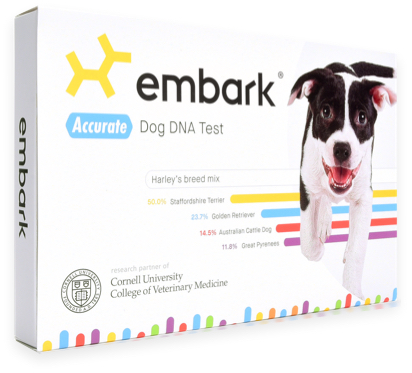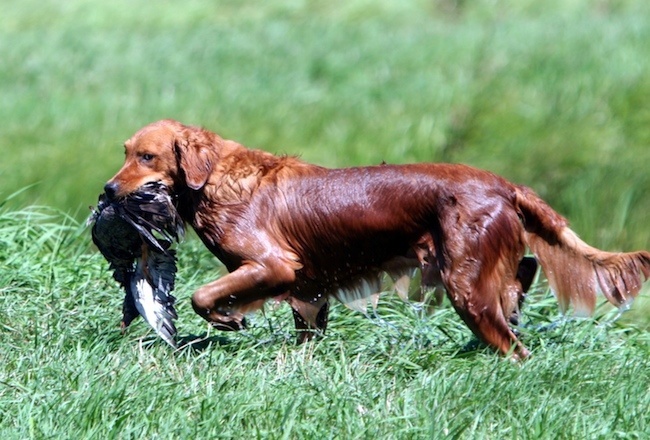We got Emma‘s DNA test results back from Embark and it turns out she is a “carrier” for Ichthyosis-A (commonly referred to as ICH, ICT, ICT-A or ICH-A). That said, some explanation is needed.
Let’s get the important stuff dealt with first. Being a carrier for ICH is relatively common and completely harmless for your pet with absolutely no symptoms whatsoever. It only becomes an issue if you plan to use that dog as a breeder and as I’ll explain below, it is completely harmless as long as your breeder (hopefully you choose us) pays attention to the genetics of the dog’s breeding partner.
I’ll use three different terms repeatedly throughout the article and it’s important you understand their meanings.
- Carrier = no presented symptoms due to the mutation – ever
- Affected = will experience symptoms
- Clear = no mutated ICH gene
What is Ichthiosis (ICH)?
Ichthyosis-A is the genetic variant that affects Golden Retrievers and is an autosomal recessive genetic mutation that affects the skin of Golden Retrievers and a few other dog breeds. The mutation prevents the outer layer of the epidermis (skin) from forming properly, resulting in skin that becomes darkened and thick, with excessive flaking. I considered grabbing some pictures but the internet is filled with worst case scenario pics and the vast majority of cases are not worst case. That said I saw no benefit in presenting a horror show.
Ichthyosis should not be confused with Seborrhea which actually IS dandruff. ICH is a genetic condition and can, in some cases, be much more severe than dandruff and is completely preventable as you will see below.
ICH is very common in Golden Retrievers. The exact percentage of this mutation in Goldens is not known but I’ve seen studies in Europe that showed 45% as carriers and almost 30% as affected in their sample. In the United States I suspect the numbers are lower due to differing opinions on handling the condition on this side of the pond but I have no studies backing that up.
The name Ichthyosis comes from the Greek word for fish because of the resemblance to fish scales resulting from this condition if your dog is “affected” (not “carrier”). A common slang name for the condition is “Fish Scale Disease”. The most common symptom is flaking of the skin similar to dandruff in humans. It is also possible to have hardening and darkening of the skin. Which symptom experienced and it’s individual severity varies and can become worse or better over time based on hormone levels and stress. The visible symptoms in an affected dog can present themselves at any stage of life but most often are seen before the puppy’s first birthday. The ONLY way to confirm ICH is via a simple, inexpensive DNA test. If you Golden gets flaky skin, it is not necessarily ICH.
In general, active ICH is not dangerous to your Golden Retrievers health. It is mostly cosmetic but can be uncomfortable and/or itchy for your pet. The symptoms can be managed to some extent with the proper shampoos and treatments but there is no cure.
Is it wise to breed a Golden Retriever that has ICH?
In general, it is completely safe to breed a Golden Retriever that is an ICH carrier with some simple precautions. In some very narrow cases, some breeders do breed an ICH affected dog but there needs to be a really good reason for the betterment of the breed conformation.
In Europe it is fairly common to breed affected dogs and many breeders just brush it off as “dandruff”. In America, we are typically more careful on this issue but it’s still a thing.
Editorial
Ironically, the American Kennel Club does not even require DNA testing on Golden Retrievers for it’s “AKC Bred with HEART” program. I find that sad since DNA testing is cheap, easy and accurate. I believe in today’s world there is no excuse for providing ICH affected puppies when that puppy will be a sterilized pet and not a conformance championship competitor and even then, it should be avoided if possible. “Carrier” is OK if handled properly when breeding; “Affected”, no so much.
How can breeders manage Ichthyosis?
The trick for preventing affected status is to know the DNA status of both breeding parents and only breed proper combinations. The following set of bullets outline how to determine how the ICH gene can be inherited based on the genes of both parents (source: First Foundation for Ichthyosis and related skin types):
Note: the % chances listed below are per puppy, not per litter.
- Parents are Clear + Clear
- All puppies are clear
- Parents are Clear + Affected
- All puppies are carriers
- Parents are Carrier + Clear
- Puppies have a 50% chance of being a Carrier
- Puppies have a 50% chance of being Clear
- Parents are Carrier + Carrier
- Puppies have a 25% chance of being Clear
- Puppies have a 50% chance of being a Carrier
- Puppies have a 25% chance of being Affected
- Parents are Carrier + Affected
- Puppies have a 50% chance of being Carrier
- Puppies have a 50% chance of being Affected
- Parents are Affected + Affected
- All puppies are affected

Conclusion
ICH-A is a completely manageable genetic mutation that is very common in Golden Retrievers. Since the American Kennel Club and European kennel clubs have not condemned it, Ichthyosis remains a thing. It is completely preventable with responsible breeding practices but unfortunately is still common.
Ichthyosis is not deadly nor typically bad for the dog’s health but it can be uncomfortable and can detract from the good looks of the dog’s coat in some cases. If a Golden Retriever is a “Carrier”, there are absolutely no health risks nor symptoms. If breeding an ICH-A “carrier”, the breeder should simply insist the mate is tested and “Clear” of ICH-A. The puppies produced will have a 50% chance of being a carrier but that matters not at all if the puppies will be sold with limited registration never breed. Even if sold with full registration where breeding is probable, producing a puppy that is a “carrier” is not evil as long and breeders pays careful attention to it.
If you care about ICH (and in my opinion you should), it is important that you only buy puppies from breeders that can show DNA tests from BOTH parents. If both parents are “Clear” then you are set. If one is a “Carrier” and the other “Clear”, you are still set since none of the puppies will be “affected”. If either parent is “affected”, you need to pay much closer attention and I’d recommend requiring a DNA test on the puppy to assure it is not “affected” before you buy it .
About the Author

Bryan Curry loves all dogs in general, especially Golden Retrievers. He has had dogs for all but 6 months of his long life and all have lived happy and much longer than average lives. Bryan and his wife Terri are co-owners of Texas TLC Goldens; a small responsible breeder producing high quality Golden Retriever puppies.
Note to our friends
Please consider sharing links to our blog posts if you find them interesting. It is a simple thing to do and sharing links not only spreads what we hope is good information, it helps our site.
Copying and using the text or images provided above in any way other than a link is prohibited.
Thanks!!!








 There are many other things that go into what qualifies a breeder as a “Good Quality breeder” so for this article I’ll narrow the down the discussion.
There are many other things that go into what qualifies a breeder as a “Good Quality breeder” so for this article I’ll narrow the down the discussion. 


 Yes, Golden Retrievers can be trained to live with loud noises and often are since they are one of the best hunting retrievers that exist but it takes practice and training from a very early age. In practice most Golden Retrievers are not trained this way since they are most often family pets. Goldens are very emotional dogs. The loving, friendly and loyal nature you value so much also means that they can also fear as much as they love. Fear is irrational and instinctual so it will win the battle of emotions if not properly trained and/or cared for.
Yes, Golden Retrievers can be trained to live with loud noises and often are since they are one of the best hunting retrievers that exist but it takes practice and training from a very early age. In practice most Golden Retrievers are not trained this way since they are most often family pets. Goldens are very emotional dogs. The loving, friendly and loyal nature you value so much also means that they can also fear as much as they love. Fear is irrational and instinctual so it will win the battle of emotions if not properly trained and/or cared for.
 A room that is preferably small with no windows and no outside walls. Basically the most quiet room in the home.
A room that is preferably small with no windows and no outside walls. Basically the most quiet room in the home.






 We know
We know  “should” be coming. Terri is also running “Ferning” tests from her dried saliva under a microscope a few times per week and we see continued evidence of progesterone. As you can see from the graphic, if free progesterone is present, she’s in her cycle somewhere.
“should” be coming. Terri is also running “Ferning” tests from her dried saliva under a microscope a few times per week and we see continued evidence of progesterone. As you can see from the graphic, if free progesterone is present, she’s in her cycle somewhere.